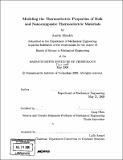Modeling the thermoelectric properties of bulk and nanocomposite thermoelectric materials
Author(s)
Minnich, Austin (Austin Jerome)
DownloadFull printable version (13.97Mb)
Other Contributors
Massachusetts Institute of Technology. Dept. of Mechanical Engineering.
Advisor
Gang Chen.
Terms of use
Metadata
Show full item recordAbstract
Thermoelectric materials are materials which are capable of converting heat directly into electricity. They have long been used in specialized fields where high reliability is needed, such as space power generation. Recently, certain nanostructured materials have been fabricated with high thermoelectric properties than those of commercial bulk materials, leading to a renewed interest in thermoelectrics. One of these types of nanostructured materials is nanocomposites, which are materials with either nanosized grains or particles on the nanometer scale embedded in a host material. Nanocomposites present many challenges in modeling due to their random nature and unknown grain boundary scattering mechanisms. In this thesis we introduce new models for phonon and electron transport in nanocomposites. For phonon modeling we develop an analytical formula for the phonon thermal conductivity using the effective medium approximation, while for electron modeling and more detailed phonon modeling we use the Boltzmann equation to calculate the thermoelectric properties. To model nanocomposites we incorporate a grain boundary scattering relaxation time. The models allow us to better understand the transport processes in nanocomposites and help identify strategies for material selection and fabrication.
Description
Thesis (S.M.)--Massachusetts Institute of Technology, Dept. of Mechanical Engineering, 2008. Includes bibliographical references (p. 95-99).
Date issued
2008Department
Massachusetts Institute of Technology. Department of Mechanical EngineeringPublisher
Massachusetts Institute of Technology
Keywords
Mechanical Engineering.